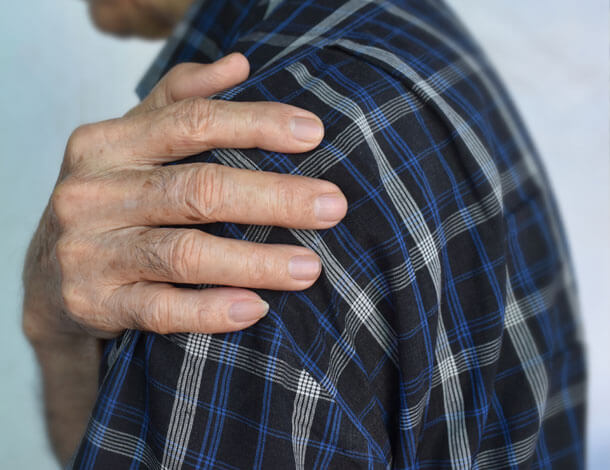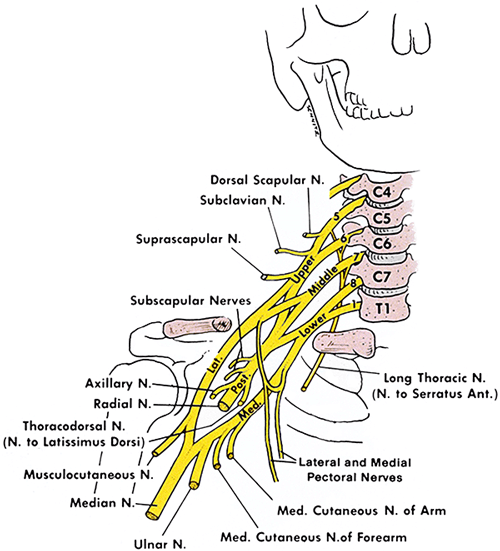What to Know About Brachial Plexus Injury and Fixing Damaged Nerves

Depending on its severity, a brachial plexus injury could be a minor inconvenience or a devastating diagnosis. Early treatment can be the difference-maker in ensuring the best possible outcome.
Our bodies are like a symphony, with our nerves as the conductors. When our nerves are functioning correctly, everything works in perfect harmony. But when nerves are injured or damaged, our bodies may be unable to move or feel as they should.
Brachial plexus injuries are common but complex, and the right treatments vary greatly depending on where they occur and how much trauma is involved.
This article looks at the common causes and symptoms of brachial plexus injury, as well as what to expect with diagnosis and the treatment options that may be considered.
What Is the Brachial Plexus?
The brachial plexus is a bundle of nerves in the shoulder that carry signals from the spinal cord to the nerves in the arm.
The brachial plexus has five nerves, each controlling a different function. Because each nerve has a unique function, the location of a brachial plexus injury is essential for doctors to know when developing a treatment plan.

The five major nerve branches of the brachial plexus are:
- Musculocutaneous Nerve: Flexes muscles in the upper arm, at both the shoulder and elbow.
- Axillary Nerve: Helps the shoulder rotate and enables the arm to lift away from the body.
- Median Nerve: Enables movement in the forearm and parts of the hand.
- Radial Nerve: Controls various muscles in the upper arm, elbow, forearm, and hand.
- Ulnar Nerve: Allows for fine motor control of the fingers.
What Can Cause a Brachial Plexus Injury?
Brachial plexus injuries most often occur when a person experiences trauma to the neck. The injury can be caused by extreme pressure, a cut to the neck, or when it’s been stretched too far. Cancer or radiation treatments can also sometimes cause trauma. Brachial plexus injuries even happen to some babies during birth.
According to the American Academy of Orthopaedic Surgeons, the number of brachial plexus injuries seems to be growing worldwide, perhaps due to increased participation in high-energy sports and higher survival rates from high-speed motor vehicle accidents.
When a brachial plexus injury occurs, some or all communication is cut off between the spinal cord and the arm, wrist, and hand. This can mean a decrease or complete loss of movement and sensation in the arm or hand.
In adults, brachial plexus injuries can be caused by:
- Blunt Trauma (Such as a Hard Fall or Car Accident)
- Athletic Injury
- Gunshot Wound
- Medical Trauma (Nerve Is Cut or Damaged During a Procedure)
- Cancer (Tumor in the Brachial Plexus)
- Radiation Therapy
How Serious Is an Injury to the Brachial Plexus?
The severity of brachial plexus injuries varies depending on the location (which nerve is impacted) and the level of trauma. When the injury is minor, it will often heal well with little to no treatment.
Minor injuries called “stingers” or “burners” are common and happen when the brachial plexus nerves get stretched or compressed. This commonly happens to athletes who play contact sports like football or wrestling.
More severe brachial plexus injuries occur when there is a tear or rupture of the nerves or when the nerve root is torn from the spinal cord. Surgical treatment is often needed to restore function when this happens. For some patients, feeling and function return to normal after treatment, while others may have chronic disability.
Learn More About Brachial Plexus Trauma
Symptoms of a Brachial Plexus Injury
The pain from a brachial plexus injury can range from mild to severe, depending on the type and extent of the trauma.
Less-severe “stinger” injuries can produce the following symptoms:
- Electric Shock or Burning Sensation That Shoots Down Your Arm
- Arm Numbness and Weakness
The symptoms of a mild brachial plexus injury can last from just a few seconds or minutes to a few days or longer.
Symptoms of more severe brachial plexus injuries can include:
- Severe Pain
- Weakness or Loss of Some Function in Your Hand, Arm, or Shoulder
- Complete Lack of Movement and Feeling in Your Arm
Types of Brachial Plexus Injuries
The three main types of brachial plexus injury include:
- Avulsion Injuries: This is the most severe type of brachial plexus injury, and it occurs when the nerve root has been pulled out of the spinal cord.
- Stretch (Neuropraxia) Injuries: This injury occurs when the nerve is mildly stretched; it may heal on its own or require nonsurgical treatments.
- Rupture: This type of injury happens when there’s a forceful stretch or tear of the brachial plexus nerve, and it can sometimes be repaired with surgery.
Diagnosis and Treatment
Because the severity and types of brachial plexus injuries can vary widely, seeing an experienced nerve specialist for a comprehensive examination and diagnosis is essential. They will examine all the nerves of the brachial plexus to pinpoint the location of your injury and determine how severe it is.
In addition to a physical exam, the specialist may do some imaging tests to identify any potential damage to the bone or tissues around the nerves of the brachial plexus. Those tests can include:
- X-ray
- MRI
- CT Scan
- Nerve Conduction Study
- Electromyogram
Mild brachial plexus injuries typically respond well to nonsurgical treatments. Your specialist may recommend one or more of the following options:
- Oral Pain Medications
- Corticosteroid Creams or Injections
- Braces, Splints, or Compression Sleeves
- Occupational or Physical Therapy
Surgical Treatments
A specialist will typically recommend surgical treatment if your brachial plexus nerves don’t recover on their own or function to the arm and hand don’t return. The specific procedure needed will depend on the type of injury and its severity.
The surgical procedures that a nerve specialist may recommend to treat a brachial plexus injury can include:
- Nerve Transfers: Undamaged nerves are rerouted into injured nerves to “wake up” paralyzed muscles or provide feeling to numb areas. These nerves can come from unaffected parts of the brachial plexus or other areas of the upper body.
- Nerve Grafts: Areas of damaged nerves are removed and replaced with nerve grafts to facilitate nerve regrowth.
- Tendon Transfers: Muscles that are still functional can be rerouted to provide otherwise lost function.
- Muscle Transfers: Healthy muscles from other body parts are moved into the arm.
- Joint Fusions: Joints that have lost mobility are stabilized by fusing the joint and trading weak motion for stability.
For severe brachial plexus injuries, it’s critical to get surgical treatment right away. Without prompt treatment, you could permanently lose the ability to feel or use your arm or hand.
Nerves heal slowly, so recovery from a brachial plexus injury can take several weeks to months, depending on the severity. Occupational therapy can help prevent muscle atrophy, and it is often recommended during recovery.
In some severe cases, surgery may not be able to return the arm or hand to normal function. Seeing an experienced nerve specialist for a proper diagnosis and treatment will give you the best chance at a positive outcome.
Trust the Experts at Indiana Hand to Shoulder Center’s Nerve Injury and Limb Pain Program
If you think you may have sustained a brachial plexus injury, schedule an appointment with the team at the IHTSC Nerve Clinic. We can evaluate your condition to see if you’d be a candidate for any of our nerve clinic’s effective techniques, therapies, and treatments.
You might also like:



